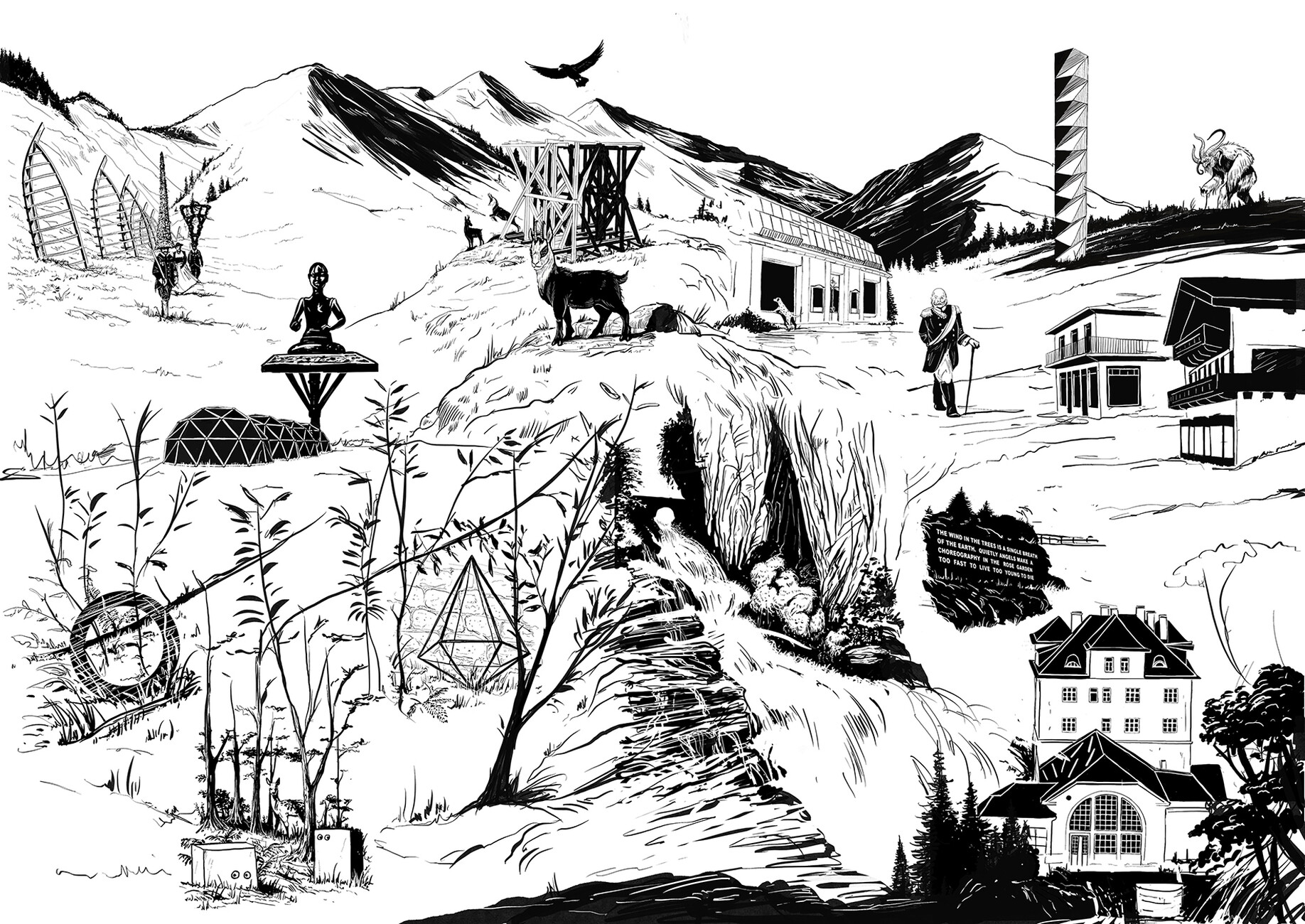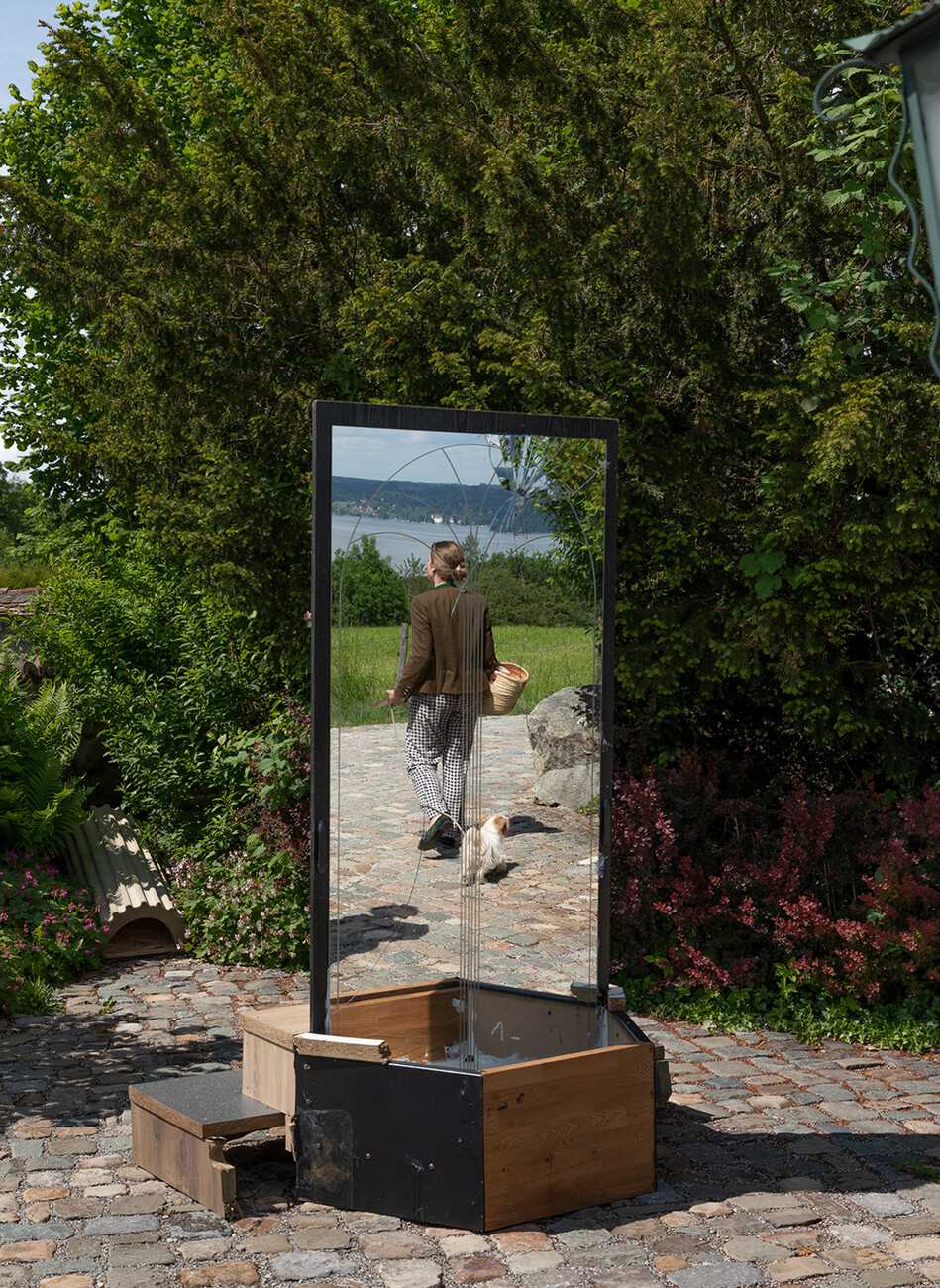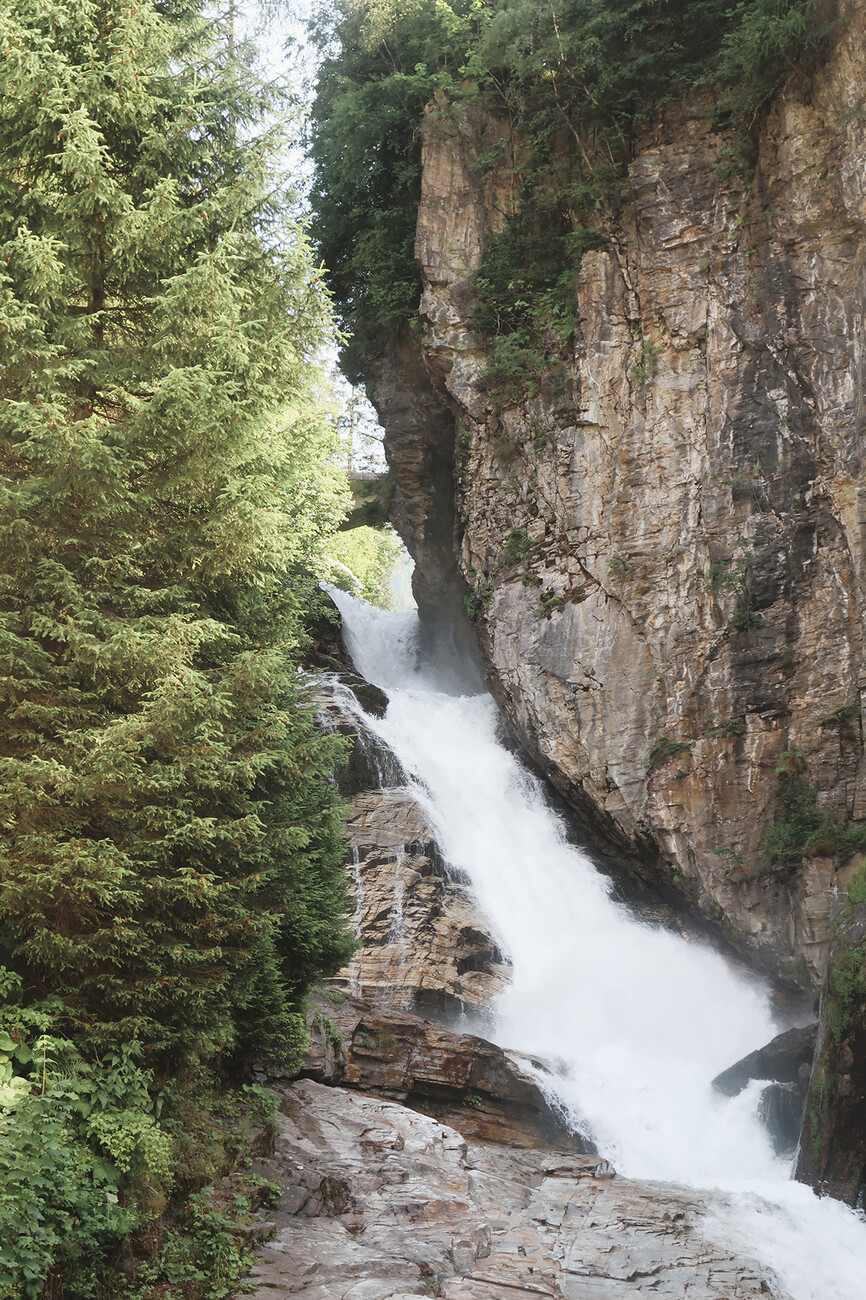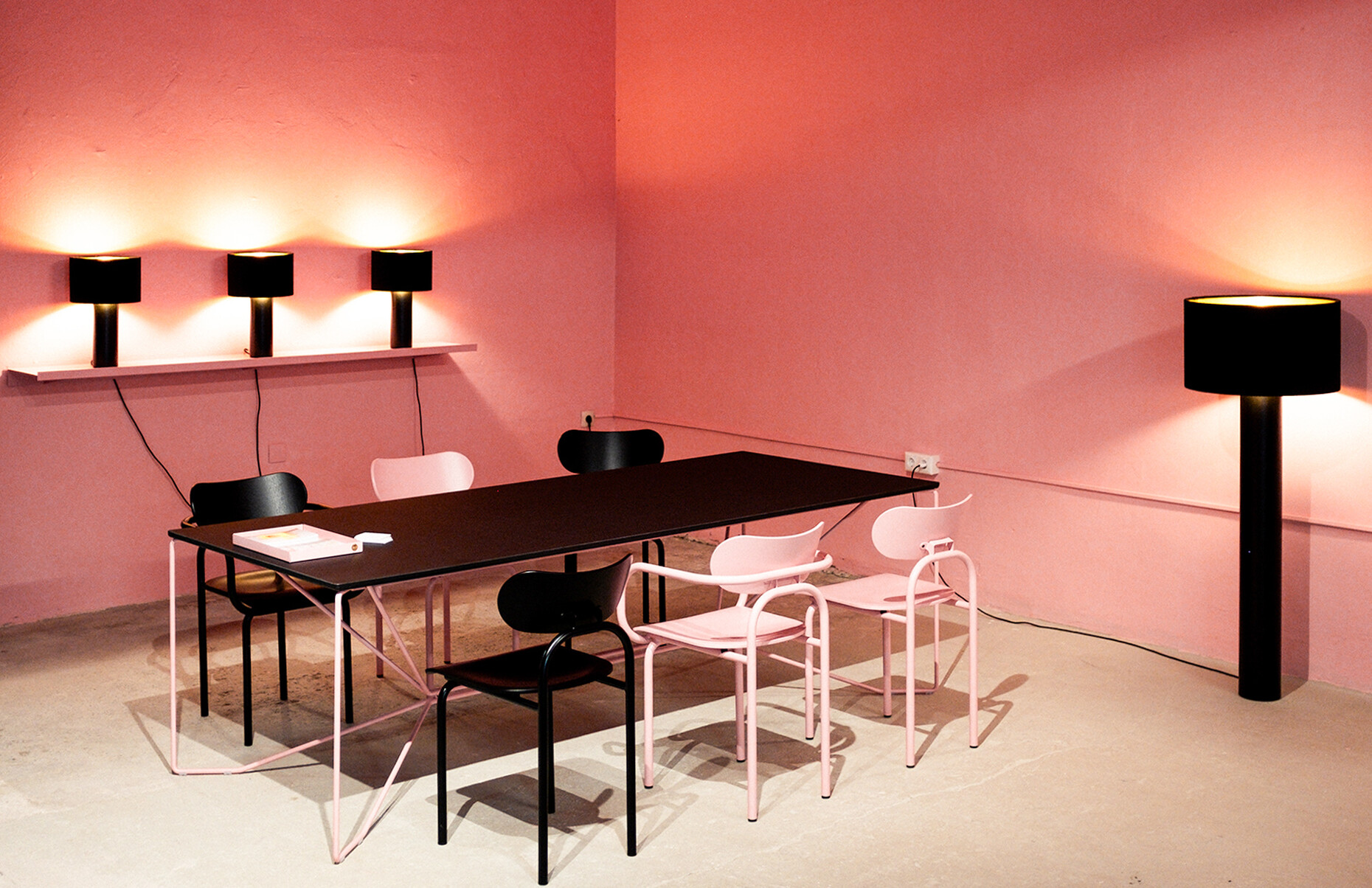Creativity over Therapy
Enhancing its image through art is now part and parcel of its marketing though Bad Gastein should not really need it: thundering waterfalls that rush right through the middle of town; high mountains and deep valleys on whose slopes multi-storey buildings nestle like the famous Grand Hotel de l’Europe – nobody else in the region built at such high altitudes as here, something that earned the resort the name “Manhattan of the Alps”. And incidentally, the architecture makes a dramatic contrast to the few Brutalist buildings on the square. And then there are the springs located under the entire town, which is hewn out of rock. Wherever you look, the water bubbles out of the ground, hot and cold, and you can bathe in secret and in public pools. In fabled radon thermal water that is slightly radioactive and boosts all manner of spa and wellness packages. The German Federal Office for Radiation Protection warns against it. Here people take a laxer attitude. Even small guest houses have their own thermal baths in the basement. And the larger hotels boast about the famous guests who once sojourned here: Sigmund Freud, for example, the founder of psychoanalysis, regularly stayed and took the waters at Hotel Excelsior, from which a winding leafy path leads to further lodgings.
So, calling the resort a bit of a mythical would still be an understatement. Nonetheless, despite various hypes from time to time Bad Gastein, once written as one word and left unchanged at the station, has never completely recovered from the demise in tourism in the 1980s. Formerly magnificent hotels and many stores still stand empty. And though après-ski guests populate the town in winter the summer months are appreciably quieter. However, as we know empty places make ideal creative spaces and so for 12 years now in the warmer months the resort has been given over to artists – some working on the interface to spatial design, while others veer towards product design or architecture. Every year, artists are invited to spend several weeks in Bad Gastein under the motto “Sommer.Frische.Kunst.” (Summer. Freshness. Art) They live here in the local guest houses and hotels such as the Miramonte whose refurbishment resulted in mid-century spa architecture was amazingly incorporated big time – and work in the power station at the waterfall or in the former stores that line the Kaiser Wilhelm Promenade.
The first installation by Pegasus Product, which is currently celebrating its launch, also exploits a bygone holiday interior: The art collective prefers to use what it finds – in this instance material from a former Berlin hotel that was located next to the studio of Gernot Seeliger, Dargelos Kersten and Anton Peitersen. “Power Peckerl” reads a sign in different languages in front of the door, advertising the myth-shrouded service that is offered inside. A treatment session that is a rethinking session and art performance rolled into one. The installation is defined by hostelry in terms of materials, as that is where they were sourced: Triangular wooden panels with a satin golden decor now adorn the walls, while in the neighboring room the trio has fashioned a couch from garbage left behind by tourism. On this same couch reclines a customer who is receiving a clandestine treatment and at the end of it will be handed a mysterious chain with a pendant.
Pegasus Product not only borrowed the name for their design from the place but also the one or other strategy: the vocabulary for their performances and installations, the speculative styling. That said, working with what is left over and largely doing without new materials has long become popular practice both in art and contemporary design. Their installation seems like a caricature of the spa and wellness trend – or is it perhaps more of an artistic homage?
A different collective has moved into the nearby Radon Pavilion, though it would be more correct to talk of a group of friends: Dennis Buck, Conny Maier, Michael Günzer and Andi Fischer all work as artists in their own right; not so long ago, it was possible to admire Maier’s large-format panorama paintings in the “Unlimited Section” at Art Basel. Now under the name “Dorf” (Village) they are collaborating as a group with alternating guests in precisely such a village setting: Buck is showing lettering which as an extension of painting can be cast from silicone or bleached by the sun on fabric. Fischer’s seemingly naive, childish painting creates direct links to art-historical references, while Maier presents figurative pictures of protagonists who seem to be somewhat withdrawn. The principle underlying the summer resort program unites artists with very different approaches, who can compete here with the spectacular panorama and the feel of the spa. Residency programs are often bound to certain thematic topics or curators’ expectations. By contrast, here the art festival has a reputation of sorts for giving participants the freedom to show what they want. And some artists simply want to spend their vacation in this spectacular place and present their art at the same time. Some come back: For example, Helga Schmidhuber was a guest herself years ago with her own summer studio; today her works are on display at the art fair by the same name. Every year the program is rewritten; in 2023, an art fair is joining the opening weekend.
In daylight and with a view of the waterfall, the fair is presenting individual items and editions mainly from Austrian and German galleries. Aside from art visitors can also admire selected design including "The Black Bowser" bowl by Coco loves Clay. The ceramic artist designed it for the exhibition of architect Marie Aigner in the Rossana Orlandi gallery during Salone del Mobile 2023. The eponymous computer game figure from Super Mario provided the inspiration for the spiky vessel. On the ground floor, Hamburg duo Victor Foxtrot (Florian Vogel and Carolin Kreidel) presents among other things its “Double U Armchair”, which is a gaudy pink here and looks like it has been made out of a single piece. In actual fact, however, it is composed of pressed beechwood and tubular steel and is only given its monochrome coat of blood orange to sage green retrospectively. And from Vienna we have publisher Verlag für moderne Kunst (VFMK), whose books and editions straddle the area between art and design.
After the weekend of the fair more artists will move into the studios in the power station, and the outcome of their work will be on display in August. In addition to the classic exhibition space, Bad Gastein itself will serve as an art space. Given that exhibitions and performances have been held here for over ten years there are a number of good anecdotes still very much alive and kicking: For example, the work of Austrian artist Clemens Wolf, who in a covert operation painted all the construction fences gold at a time when the town was still undergoing radical changes. While only photos still exist of this temporary action other works were allowed to stay permanently. Produced specially this year in the form of ink drawings by Sebastian Menschenmoser a map of the hiking trail leads to the large-format sculptures (for example by Kazunori Kura or Olaf Holzapfel) which stand out against the green hills as wooden sculptures and installations that are light and airy.
Until 2 September 2023
Wednesday to Saturday, 2 to 6 pm
Art Weekend
11 – 13 August 2023
Some permanent installations are on view around the clock.











